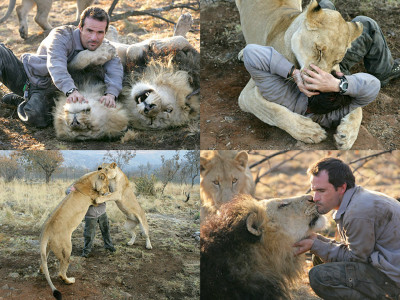Lion yawns may have a role of 'strengthening cohesion with peers'

Yawn contagion promotes motor synchrony in wild lions, Panthera leo --ScienceDirect
https://www.sciencedirect.com/science/article/abs/pii/S0003347221000579
Yawning helps lions synchronize their groups' movements | Science News
https://www.sciencenews.org/article/lion-yawn-contagious-synchronize-group-movement-hunt
Yawning in public tends to give the impression of being 'sleepy' or 'boring', but in reality there are various theories about the question 'Why do humans yawn?' For example, yawning has the physiological function of increasing blood flow to the head and supplying oxygen to the brain, so there is a theory that it promotes the transition from rest to awakening, and it also has the function of cooling the brain. The theory is also proposed.
In addition, there is a theory that it has a role to promote group behavior within a specific group due to the phenomenon of yawning from one individual to another. It has been reported that in humans, people with higher empathy are more likely to yawn, and children who are prone to autism are less likely to yawn.

A research team led by Elisabetta Palagi, an ethologist at the
The research team analyzed the time and frequency of yawning and the behavior before and after yawning from the footage of the lion. As a result, the frequency of spontaneous yawning by lions was often in a relaxed state, consistent with the 24-hour activity cycle, in connection with the activity of yawning between drowsiness and arousal. It seems that it was suggested that there is.
It was also found that a lion who saw another individual yawning was 139 times more likely to yawn himself within 3 minutes of seeing the yawn. Quantitative analysis has revealed that yawning is more common among lions.
In addition, the research team found that 'individuals who saw other lions yawn were 11 times more likely to imitate the behavior of the original lion after yawning.' This shows the synchronization of the movement that 'Lion A yawns and then stands up and walks around, and then Lion B who sees the situation also yawns and then stands up and walks around.' It turned out that he was moving to actions other than.

Palagi points out that yawning transmission may be important for maintaining the social cohesion of the herd. Since lions work together in herds to hunt and raise offspring, it is beneficial to use yawns to harmonize the movements of the herd. 'If the yawning transmission evolves to create and promote cohesion, it is necessary for the two to make the same movement after the yawning transmission to enhance the interaction.'
According to Palagi, yawning also indicates changes in physiological and psychological states, and yawning is an individual in a social group who 'experiences some sort of internal change.' It may be a way to tell friends. “Yawning is a widespread activity, but I think it's also one of the most mysterious,” said Paragi.
Related Posts:







